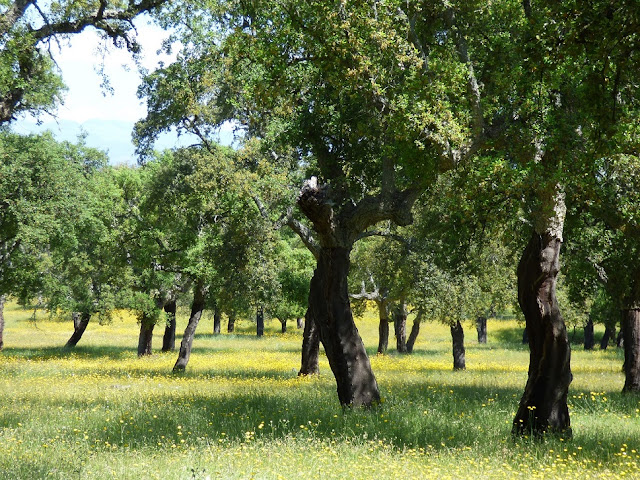 |
| Woodland the colour of orioles (Martin Kelsey) |
The cold wet spring has left us with a prolongation of colour which might be considered well-deserved following the onslaughts of sometimes torrential rain and the storms of the last few weeks. Now, as at last the temperature starts to catch-up, my fleece jacket is consigned to the wardrobe and I can stand at the kitchen door at dusk, listening to the Nightingales and watching the first summer stars break through the gloaming. At the base of the wall beside the orange tree, whose blossom has cast a heavy fragrance to this corner of the house, headily mixed with a nearby jasmine, luminesence the colour of Spica radiates from the abdomens of glow-worms. I count three in the space of just a few feet.
 |
| Glow-worm (Patrick Kelsey) |
The spread of egg-yolk marigold yellow has created a mantle of colour in the
dehesas and none so startling as that in a cork oak
dehesa that I visited just a few days ago (see photo at the top of post). Where the harvested bark had been removed, the trunk which turns a mahogany red in the weeks after harvest, now half way through the nine-year cycle is blackened. The vividness of the contrast between the ground flora and the gallery of scarred trunks was that of a male Golden Oriole. It was a landscape with a boldness of tone that, like the bird, does not seem to fit into a temperate, albeit Mediterranean consciousness. It is a bolt of tropical brazenness. And indeed, as I stood the rolling, stroking liquid notes of oriole song curled out of the foliage and for one brief instance, a yellow and black dart-shaped bird ventured into my vision on a trajectory back into cover. So sought after by birders when they arrive in early April, by mid-May Golden Oriole song accompanies one along most woodland walks here.
 |
| Golden Oriole (John Hawkins) |
For most of us this has been the wettest and coolest late spring that we can remember. The orchids have been extraordinary, with the late flowering species taking full advantage of such favourable conditions. Our very special variety of Bee Orchid,
Ophrys apifera var. almaracenis, known only from a few sites close to the town of Almaráz is been putting on a glorious show at the moment.
 |
| The Almaraz Bee Orchid (Martin Kelsey) |
But there have been losers as well. The long spell of cold weather and heavy rain struck at a critical time for many birds, especially those with chicks in the nest. Ángel Sanchez, the Director of Conservation here in Extremadura has advised us that perhaps half of the breeding pairs of Bonelli's Eagles have lost their chicks this year - and this is a species already showing poor breeding success because of shortages of prey. Ground-nesting birds will also have fared badly. May this year has been extraordinarily dramatic, with ink-black skies and billowing colours. The landscape pounds with vigour. Now as summer approaches we have a heady aftermath.
 |
| Mid-May 2016: storms over the plains near Trujillo (Martin Kelsey) |








Comments